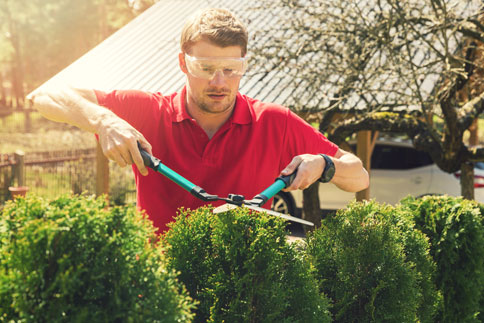Watch Out for Eye Injuries
Did you know that more than 90 percent of eye injuries can be prevented by simply taking a few precautions and wearing safety glasses? Below are three situations where you could easily sustain an eye injury.
Using power tools
More power means more chances to hurt yourself. If you use a lawn mower, leaf-blower, drill or similar power tools, you need protective eyewear. These glasses should have a snug, wrap-style frame to decrease the likelihood of small, airborne particles getting behind the lenses.
If you wear corrective lenses, you can buy goggles that will fit over your glasses. But a better and more comfortable option is to purchase a pair of customized safety eyewear with polycarbonate lenses from an optical shop.
We often deal with eye injuries from home DIY projects, yardwork, trimming bushes or trees that could easily be avoided with protective eyewear.
If you are in the market for new glasses, check out the 50 percent off frame sale on Oct. 24 at CentraCare Eye Center.
Having a vehicle accident
Air bags have saved thousands of lives, but it’s possible to sustain a corneal abrasion or other eye injury from air bags deploying during an accident. To reduce your risk of injury to your eyes and head from air bags, follow these tips:
- Make sure you are wearing your seatbelt and that it’s properly adjusted.
- Adjust the headrest of your seat for proper support.
- Sit at least 10 inches away from the steering wheel.
- Don’t smoke while driving.
- Have children sit in the back seat with seatbelts and safety seats properly adjusted.
Opening a champagne bottle
With the holidays approaching fast, you may be celebrating with a bottle of bubbly. A flying cork from a bottle of champagne can abrade or rupture the eyeball, cause bleeding inside the eye or a detached retina, dislocate the eye’s lens or damage the orbital bone structure.
If champagne and sparkling wine bottles haven’t been fully chilled, the gas in the bubbles expand. This causes the corks to come out much more forcefully — at speeds of up to 50 mph. It is recommended that you chill the bottles to 45 degrees Fahrenheit or colder before you open them. Follow these tips to reduce your chance of injury:
- Don’t shake the bottle before opening it, because this just increases the pressure inside and therefore the speed at which the cork leaves the bottle.
- Point the cork away from yourself and others while opening the bottle.
- After removing the foil, hold down the cork with your palm as you remove the wire. Do not use a corkscrew.
- Don’t push under the cork. Instead, place a towel over it, and keep your palm on the cork as you twist the base of the bottle. It still will make that delightful “pop!”
